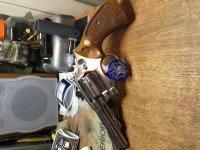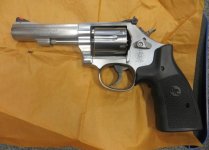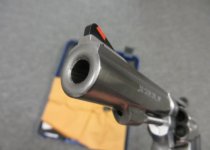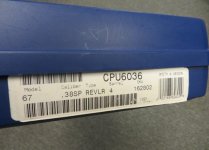This is another advance peek at what will be a future article in Dillon's Blue Press catalog/magazine. As always, constructive comments welcome.
John
The S&W Model 67 Combat Masterpiece Stainless Revolver

Chevys. Fords. Hot dogs. Apple pie. Smith & Wesson .38 Special revolvers. All have been around for quite some time, and are as familiar to us as the backs of our hands. Maybe you didn’t realize it, but revolvers chambered for the .38 Special cartridge have been part of our United States heritage since 1899! That’s when Smith & Wesson introduced its Model 1899 – the very first S&W medium frame (later to be known as the “K-frame”) double-action swing-out cylinder revolver. This was the first handgun to be chambered for the then-new .38 Special, which in fact was a slightly lengthened U.S. service cartridge called the .38 Long Colt. First loaded with black powder, the .38 Special round was very soon thereafter loaded with smokeless powder.
Both the .38 Special and the S&W revolvers that chambered it became enormously popular. The .38 Special has become the most accepted center fire handgun round in the U.S. today. When introduced it quickly became the de facto standard for police forces nationwide. It’s also been used by our military, and many civilians have found that Smith’s K-frames handle “just right.” The .38 Special, first lacking some punch with low velocities and round nose bullets, is no slouch today.
Strengthened guns, higher velocity loadings and expanding bullets have made modern rounds more than adequate for self-defense. Double action revolvers are perhaps the most reliable handguns made, and learning to use them is a piece of cake for almost everybody.
The S&W K-frames have come a long way since they were first conceived so long ago. While the first ones could fire if dropped on their hammers, S&W soon developed a hammer block that allowed firing only when the trigger was deliberately pulled. The first method used could be less than reliable if rust or congealed gun oil inhibited the block from moving into position. During World War II, a second method was developed – a positively-activated sliding block that is virtually impossible to defeat in use. It’s still standard for external-hammer-equipped Smith & Wesson revolvers today.
The .357 magnum cartridge and revolvers chambered for it came into use in 1935. The .357 guns were able to chamber and fire .38 specials as well, because the magnum cartridge was in fact a slightly longer round than the .38. The .357 became popular, but a steady demand for the .38 special continued. Many folks preferred it over the heavy-recoiling magnum; it was much more manageable and pleasant to shoot. Quick follow-up shots were much easier to execute.
.38 Special revolvers are still quite widely used, and S&W has continued to refine and improve the breed. The “Military and Police” revolvers evolved into what is now known as the Model 10 following Smith’s use of model numbers for its guns in 1957. Micrometer adjustable sights and a sloped (Baughman) front sight characterized the “K-38 Combat Masterpiece” revolver. This was considered the ultimate .38 revolver at the time for serious social work. It was available either blued or nickel plated. This fine revolver became the Model 15 in 1957. Many were used in our armed forces.
In 1972, S&W took the Model 15 a step further, making a new gun that was even more desirable for defense and severe usage. The Model 67 “K-38 Combat Masterpiece Stainless” was essentially the same gun as the Model 15, except that it was made with stainless steel rather than being blued or plated. It was a 6-shot handgun, and weighed 34 ounces empty. A 4” pinned barrel was standard, and the front sight soon after introduction was fitted with a red plastic insert for higher visibility. The first rear sights were also made from stainless steel, but these were soon changed to black to prevent sight glare. Both the rear sight leaf and the barrel rib were grooved. Unlike its .357 brother, the Model 66, the new 67s had no ejector shroud and the barrels were tapered to save weight. Walnut frame-fitting “magna” stocks were standard. The backstrap and forestrap had 10 grooves for better retention. An overtravel stop for the trigger was incorporated, but it can be easily removed if desired. This gun will handle +P and +P+ heavy loadings as well as the old 38/44 increased pressure rounds.
Many police departments from the 1940s through the mid-1980s still stuck with the .38 Special cartridge, and specified guns chambered for it as their standard issue. A good number of departments carrying .357 revolvers required their officers to use only .38 Special rounds in them, fearing over-penetration and liability for injury to nearby innocent bystanders. The Model 67 had found its niche with the police, and many used examples will be found today with police identification markings.
Model 67s underwent some changes over the years. In 1977 with the Model 67-1, the gas ring was changed in location from the yoke to the cylinder. The handgun illustrated is one of these, and left the factory in April, 1978. It was obtained from the estate of an individual who bought it new but seldom fired it. The nostalgic pinned barrel was abandoned in 1982 to speed production. The barrel pin was previously used to anchor the barrel in the frame, preventing barrel rotation. Friction alone holds modern barrels in place. In 1988, the Model 67-2 appeared, featuring a new yoke retention system, a “floating” hand (the part that rotates the cylinder), a radius stud package and a re-designed hammer nose bushing. 1993 saw the Model 67-3, involving a change in the configuration of the extractor. The frame was also drilled and tapped under the slightly modified rear sight leaf for scope mounts. Additionally, rubber Hogue grips were used.
In 1996, the square butt was dropped in favor of the round version. Then in 1997, the shape of the cylinder release thumbpiece was changed, and the trigger became a metal injection molded (MIM) part.
With the Model 67-4 in 1998, the frame was changed to eliminate the cylinder stop stud, the grip frame grooving was stopped, MIM parts were used, and a floating firing pin in the frame necessitated some changes to the internals. The formerly graceful profile of the frame was, in my opinion, negatively affected. In 2001, to help comply with numerous regulations, a fired case was included with each gun shipped. In 2002, an internal key lock system was introduced with the Model 67-5. This was a sop to certain overzealous “gun control” politicians. The “ugly hole in the side” is still controversial, and many feel it has no place on any handgun, since possible malfunctions of the key lock could tie up the gun and be disastrous in defense situations. Interestingly, some “dash 5s” have been observed to have shipped as recently as late 2016; these were determined to be “cleanups” using in-stock older parts.
In 2004, a two-piece sleeved barrel was authorized for the Model 67-6. Also appearing were some heavy non-tapered conventional barrels with no ejector shroud. These were probably older parts cleanups. The Model 67-6 is still being made and continues to be popular.
Although semiautomatics and “plastic”-framed pistols have now become all the rage, the Model 67 is still in demand, particularly in the civilian sector. It has been continuously manufactured since 1972. Those who think the .38 Special cartridge is dead definitely have another think coming! It’s still well-liked and available everywhere. The Model 67 represents perhaps the greatest example of a medium-frame revolver in this caliber, and occupies a singular place among the classics. The earlier ones through the “dash 3” examples are most sought after and the prices on these continue to escalate.
(c) 2017 JLM
John
The S&W Model 67 Combat Masterpiece Stainless Revolver

Chevys. Fords. Hot dogs. Apple pie. Smith & Wesson .38 Special revolvers. All have been around for quite some time, and are as familiar to us as the backs of our hands. Maybe you didn’t realize it, but revolvers chambered for the .38 Special cartridge have been part of our United States heritage since 1899! That’s when Smith & Wesson introduced its Model 1899 – the very first S&W medium frame (later to be known as the “K-frame”) double-action swing-out cylinder revolver. This was the first handgun to be chambered for the then-new .38 Special, which in fact was a slightly lengthened U.S. service cartridge called the .38 Long Colt. First loaded with black powder, the .38 Special round was very soon thereafter loaded with smokeless powder.
Both the .38 Special and the S&W revolvers that chambered it became enormously popular. The .38 Special has become the most accepted center fire handgun round in the U.S. today. When introduced it quickly became the de facto standard for police forces nationwide. It’s also been used by our military, and many civilians have found that Smith’s K-frames handle “just right.” The .38 Special, first lacking some punch with low velocities and round nose bullets, is no slouch today.
Strengthened guns, higher velocity loadings and expanding bullets have made modern rounds more than adequate for self-defense. Double action revolvers are perhaps the most reliable handguns made, and learning to use them is a piece of cake for almost everybody.
The S&W K-frames have come a long way since they were first conceived so long ago. While the first ones could fire if dropped on their hammers, S&W soon developed a hammer block that allowed firing only when the trigger was deliberately pulled. The first method used could be less than reliable if rust or congealed gun oil inhibited the block from moving into position. During World War II, a second method was developed – a positively-activated sliding block that is virtually impossible to defeat in use. It’s still standard for external-hammer-equipped Smith & Wesson revolvers today.
The .357 magnum cartridge and revolvers chambered for it came into use in 1935. The .357 guns were able to chamber and fire .38 specials as well, because the magnum cartridge was in fact a slightly longer round than the .38. The .357 became popular, but a steady demand for the .38 special continued. Many folks preferred it over the heavy-recoiling magnum; it was much more manageable and pleasant to shoot. Quick follow-up shots were much easier to execute.
.38 Special revolvers are still quite widely used, and S&W has continued to refine and improve the breed. The “Military and Police” revolvers evolved into what is now known as the Model 10 following Smith’s use of model numbers for its guns in 1957. Micrometer adjustable sights and a sloped (Baughman) front sight characterized the “K-38 Combat Masterpiece” revolver. This was considered the ultimate .38 revolver at the time for serious social work. It was available either blued or nickel plated. This fine revolver became the Model 15 in 1957. Many were used in our armed forces.
In 1972, S&W took the Model 15 a step further, making a new gun that was even more desirable for defense and severe usage. The Model 67 “K-38 Combat Masterpiece Stainless” was essentially the same gun as the Model 15, except that it was made with stainless steel rather than being blued or plated. It was a 6-shot handgun, and weighed 34 ounces empty. A 4” pinned barrel was standard, and the front sight soon after introduction was fitted with a red plastic insert for higher visibility. The first rear sights were also made from stainless steel, but these were soon changed to black to prevent sight glare. Both the rear sight leaf and the barrel rib were grooved. Unlike its .357 brother, the Model 66, the new 67s had no ejector shroud and the barrels were tapered to save weight. Walnut frame-fitting “magna” stocks were standard. The backstrap and forestrap had 10 grooves for better retention. An overtravel stop for the trigger was incorporated, but it can be easily removed if desired. This gun will handle +P and +P+ heavy loadings as well as the old 38/44 increased pressure rounds.
Many police departments from the 1940s through the mid-1980s still stuck with the .38 Special cartridge, and specified guns chambered for it as their standard issue. A good number of departments carrying .357 revolvers required their officers to use only .38 Special rounds in them, fearing over-penetration and liability for injury to nearby innocent bystanders. The Model 67 had found its niche with the police, and many used examples will be found today with police identification markings.
Model 67s underwent some changes over the years. In 1977 with the Model 67-1, the gas ring was changed in location from the yoke to the cylinder. The handgun illustrated is one of these, and left the factory in April, 1978. It was obtained from the estate of an individual who bought it new but seldom fired it. The nostalgic pinned barrel was abandoned in 1982 to speed production. The barrel pin was previously used to anchor the barrel in the frame, preventing barrel rotation. Friction alone holds modern barrels in place. In 1988, the Model 67-2 appeared, featuring a new yoke retention system, a “floating” hand (the part that rotates the cylinder), a radius stud package and a re-designed hammer nose bushing. 1993 saw the Model 67-3, involving a change in the configuration of the extractor. The frame was also drilled and tapped under the slightly modified rear sight leaf for scope mounts. Additionally, rubber Hogue grips were used.
In 1996, the square butt was dropped in favor of the round version. Then in 1997, the shape of the cylinder release thumbpiece was changed, and the trigger became a metal injection molded (MIM) part.
With the Model 67-4 in 1998, the frame was changed to eliminate the cylinder stop stud, the grip frame grooving was stopped, MIM parts were used, and a floating firing pin in the frame necessitated some changes to the internals. The formerly graceful profile of the frame was, in my opinion, negatively affected. In 2001, to help comply with numerous regulations, a fired case was included with each gun shipped. In 2002, an internal key lock system was introduced with the Model 67-5. This was a sop to certain overzealous “gun control” politicians. The “ugly hole in the side” is still controversial, and many feel it has no place on any handgun, since possible malfunctions of the key lock could tie up the gun and be disastrous in defense situations. Interestingly, some “dash 5s” have been observed to have shipped as recently as late 2016; these were determined to be “cleanups” using in-stock older parts.
In 2004, a two-piece sleeved barrel was authorized for the Model 67-6. Also appearing were some heavy non-tapered conventional barrels with no ejector shroud. These were probably older parts cleanups. The Model 67-6 is still being made and continues to be popular.
Although semiautomatics and “plastic”-framed pistols have now become all the rage, the Model 67 is still in demand, particularly in the civilian sector. It has been continuously manufactured since 1972. Those who think the .38 Special cartridge is dead definitely have another think coming! It’s still well-liked and available everywhere. The Model 67 represents perhaps the greatest example of a medium-frame revolver in this caliber, and occupies a singular place among the classics. The earlier ones through the “dash 3” examples are most sought after and the prices on these continue to escalate.
(c) 2017 JLM
Last edited:









